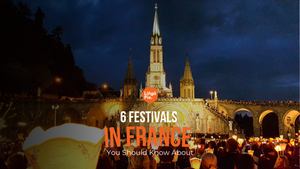You've memorized your verb conjugations and can order a café au lait without hesitation, but are you truly ready for France? The truth is, textbooks and language apps only scratch the surface of French culture. If you genuinely want to learn and appreciate the language better, then a clear understanding of French customs will undoubtedly help provide that much-needed context.
I’ve spent years navigating the cultural nuances of France, and I’m here to share all the unwritten rules that’ll help you blend in. Let’s begin!
- 4 Seasons In French: A Vocab Guide For Beginners
- 5 French Accent Marks You Need To Know
- 9 Best Short Stories In French For Beginners

French Traditions You Need To Know
When I first visited France, my carefully practiced phrases couldn’t save me from cultural missteps. Understanding these traditions will help you navigate French social situations confidently and connect with locals in ways most tourists miss.
Enjoy a long, leisurely mealtime
A traditional French meal typically follows a structured sequence: entrée (starter), plat principal (main course), fromage (cheese), and dessert. Both lunch and dinner are seen as important communal moments, where taking one’s time is valued and rushing through a meal is considered impolite. It’s not uncommon for meals to last between one and two hours, even on weekdays.
Reflecting this cultural priority, many shops (especially in smaller towns) close between 12 pm and 2 pm, allowing locals to fully enjoy their midday meal away from their desks.
La Bise (Cheek Kissing)
La bise is the traditional French cheek kiss that is a common form of greeting among friends, family, and sometimes colleagues. The number of kisses varies by region: in Paris, two kisses are the norm, while in parts of southern France, three or even four are customary. Always begin by offering your left cheek (on the other person’s right side) and follow your host’s lead.
Among men, handshakes are more typical unless they greet close female friends or relatives, in which case la bise is appropriate. In business settings, it’s best to wait for your French counterpart to initiate. Just note that a handshake remains the standard professional greeting unless a more familiar rapport has been established.

Les Soldes (Biannual Sales)
In France, sales periods are strictly regulated, taking place only twice a year: in winter (starting in January) and in summer (starting in July), each lasting six weeks. These are major shopping events eagerly anticipated by locals and visitors alike. During les soldes, store windows are adorned with bold "Soldes" signs advertising discounts that progressively deepen as the weeks go on.
Popular and high-demand items, however, tend to sell out quickly. Seasoned French shoppers often plan ahead, scouting desired pieces well before the sales start and making their purchases as soon as the first markdowns hit. Be prepared for bustling stores and larger-than-usual crowds during this festive retail season.
Bread Etiquette
The baguette accompanies almost every meal but is handled differently than you might expect. Place bread directly on the tablecloth (not on your plate), and tear off bite-sized pieces rather than biting the whole piece. Also, don’t expect butter with your dinner bread, as butter is typically reserved for breakfast in France.
The crusty end of the baguette, known affectionately as le croûton or le quignon, is often considered the tastiest part, which is why you’ll frequently see locals nibbling it as they stroll home from the bakery.
Market Day Traditions
Each town has designated market days when locals shop for fresh produce, cheese, and meats directly from producers. When browsing, it’s polite to ask vendors “Je peux ?” before touching any produce. Also, don’t forget to use local terms where possible, such as “une barquette de fraises” (a punnet of strawberries), and always greet the seller with a friendly “Bonjour” before making a purchase.
As a tip, remember that regional markets often feature specialties you won’t find elsewhere, like violet-flavored treats in Toulouse or specific cheese varieties in Normandy.

Café Culture
French coffee culture centers around small, strong espressos enjoyed while seated. "Un café" gets you an espresso, "un allongé" is slightly diluted, and "un café crème" resembles a small latte. Coffee breaks are social occasions where people are expected to linger at outdoor tables, watching the world go by.
One important note: The check never arrives until you specifically request it with "L'addition, s'il vous plaît." Prompting diners to leave is considered poor service, as café visits are meant to be leisurely and unhurried.
Being Late
Arriving exactly on time for social gatherings is actually considered too eager in France. For dinner invitations, showing up 10-15 minutes after the stated time is standard practice—what French people call "le quart d'heure de politesse" (the polite quarter hour). This differs dramatically for business meetings, where punctuality remains important. Restaurant reservations also follow this pattern; if you book for 8 pm, the table often won’t be ready until 8:15.
Dinnertime Schedule
Dinner in France starts noticeably later than in many countries, rarely before 7:30 pm and often closer to 8:30 pm. Restaurants typically don't begin dinner service until 7 pm, and arriving at 6 pm signals your tourist status immediately. This later schedule extends to evening activities, with movies, concerts, and social gatherings starting around 9 pm.
Suppose you adjust your meal schedule to match local customs. In that case, you’ll enjoy a livelier dining experience and avoid the awkwardness of sitting alone in an empty restaurant or arriving too early to an evening event.

La Fête Nationale (Bastille Day)
July 14th transforms France with military parades, fireworks, and firefighter-hosted dances called "bals des pompiers." Unlike some countries’ national celebrations focused on backyard barbecues, Bastille Day encourages public celebration in community spaces. Each town has its own traditions, from historical reenactments to lantern-lit evening processions. Smaller towns often celebrate on July 13th as well, offering a more local experience than the massive Paris celebrations.
Sunday Family Gatherings
Sundays in France center around extended family meals, often lasting from midday until early evening. Most shops remain closed, and restaurants fill with multi-generational groups enjoying lengthy conversations over several courses. Public parks become gathering spots for family picnics during warmer months.
If you are invited to a French home for Sunday lunch, bringing a small gift, such as flowers, a bottle of wine, or a dessert is customary. Be prepared to stay for several hours as these meals are meant to be savored slowly. Showing eagerness to rush off is considered impolite, so embrace the experience and settle in.
La Rentrée (The Return)
In France, La Rentrée or “the return” happens in early September and signals the true start of the year for much of the country. After the long summer break, schools reopen, businesses resume full operations, and cultural life starts with new exhibits, performances, and events. This period also sees a surge in new apartment rentals, job changes, and relationship beginnings or endings.
Shopping areas also become noticeably busier as families prepare for this fresh start during this time. Planning your trip during late August means experiencing a France partially on pause before this energetic restart.

Greeting with "Bonjour"
Entering any shop, restaurant, or public space without saying "Bonjour" marks you immediately as an outsider. This essential greeting establishes respect before any transaction occurs, and skipping it can result in noticeably colder service.
After about 6 pm, “Bonsoir” (good evening) replaces “Bonjour.” Whether addressing a cashier, server, receptionist, or even fellow elevator passengers, the greeting is almost always accompanied by eye contact and a brief nod or smile.
Cheese Course
The cheese plate arrives after the main course but before dessert, with selections typically presented clockwise from mildest to strongest. Never cut the "nose" (tip) off Brie or Camembert—instead, slice it like a pie from the center outward. Take modest portions of several varieties rather than a large piece of one type. Regional cheeses connect deeply to local identity, so expressing appreciation for a local specialty creates immediate goodwill with French hosts.
Basic French Phrases For Your Trip
These practical phrases connect directly to the traditions above.
| Phrase | Pronunciation | When to Use |
|---|---|---|
| Bonjour/Bonsoir | bon-ZHOOR/bon-SWAHR | Every time you enter a shop/restaurant |
| L'addition, s'il vous plaît | lah-dee-see-ON, seel voo PLEH | When you need the check (won't come automatically) |
| Je voudrais... | zhuh voo-DREH | "I would like..." (ordering food/drinks) |
| Où sont les toilettes? | oo son lay twa-LET | "Where is the bathroom?" |
| Parlez-vous anglais? | par-lay VOO ahn-GLEH | "Do you speak English?" |
| C'est combien? | say kom-BYEN | "How much is it?" |
| Excusez-moi | ex-kew-zay MWAH | "Excuse me" (getting attention or apologizing) |
| Merci beaucoup | mare-SEE boh-KOO | "Thank you very much" |
| Je ne comprends pas | zhuh nuh kom-PRAHN pah | "I don't understand" |
| À quelle heure ouvre/ferme...? | ah kel UR oov-ruh/ferm | "What time does... open/close?" |
Want to learn more? Read these French guides as well!
- Can You Pronounce These Old French Names? [French Language Day Quiz]
- 15 French Slang Phrases and Words You Need to Know
- How To Learn French With News In Slow French [Guide]
Learn About French Traditions Through French TV
To understand French culture, it helps to look beyond language textbooks or apps. Films and TV shows offer an authentic view of how traditions are experienced in daily life. Watching characters navigate meals shows exactly when cheese is served, how long people typically stay at the table, and the body language accompanying a polite cheek kiss. These kinds of details are hard to learn from written explanations alone, but they make a real difference when trying to interact naturally in France.
Regional French programming also helps reveal the country’s cultural diversity. You will hear different accents, encounter local expressions, and observe traditions that vary from one region to another. For example, a film set in Alsace might show local holiday customs, while a series based in Provence could teach you the vocabulary and atmosphere of a typical outdoor market.

Learn French With Lingopie
If you want to deepen your understanding of French culture while improving your language skills, watching authentic films and TV shows is one of the most effective ways to do it. Lingopie makes this easier by combining language learning with real cultural insight. Try it today and see how much more you can learn beyond the textbook.









